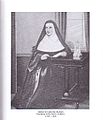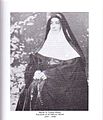- All Hallows' School
-
This article is about All Hallows' School in Brisbane, Australia. For the school in Dorset, England, formerly called Allhallows School, see Allhallows College. For the college in Dublin, Ireland, see All Hallows College.
All Hallows' School 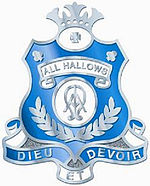 French: Dieu et DevoirGod and Duty
French: Dieu et DevoirGod and DutyLocation Brisbane, Queensland, Australia Coordinates 27°27′38″S 153°2′1″E / 27.46056°S 153.03361°ECoordinates: 27°27′38″S 153°2′1″E / 27.46056°S 153.03361°E Information Type Private, Single-sex, Day school Denomination Roman Catholic, Sisters of Mercy Established 1861 Employees ~93 (full-time)[1] Enrolment ~1,346[1] (2007) Colour(s) Light blue, white and rust
Website www.allhallows.qld.edu.au/ All Hallows' School is a Catholic day school for girls, located close to the central business district of Brisbane, Queensland.
Founded in 1861, the school follows in the tradition of the Irish Sisters of Mercy, and caters for over 1,300 girls from years five to 12.[1] The school was the first permanent home of the Sisters of Mercy in Queensland, and is the oldest surviving secondary school in Brisbane.[2]
All Hallows' is a member of the Association of Heads of Independent Schools of Australia (AHISA),[3] the Alliance of Girls' Schools Australia,[4] and the Australasian Mercy Secondary Schools Association.[5]
The school's motto is in French, Dieu et Devoir (English: "God and Duty"). This motto was formulated in 1911, 50 years after the school opened. The French language was chosen for the motto on the basis of the strong French influence in the school's early years.[citation needed]
Contents
History
19th century
The story of the foundation of All Hallows' School must be set against the rudimentary "pioneer" education system and bitter sectarian disputes in Queensland education during the 1850s and early 1860s. According to Johnston (1982, p. 104), until 1860, "secondary education tended to receive a fairly low priority in state thinking – which was not surprising since the provision of a primary level was so difficult, to difficult to manage". He continues:
"There were no state initiatives to provide its own system until 1912. Secondary education, seen as a perquisite of middle-class life, suitable for the children of business and professional men and established pastoralists, was allowed to be offered by private and church bodies" (1982, p. 104)
In 1860, the year before the foundation of the school, however, landmark legislation was passed by the Queensland colonial parliament providing for the functioning of the first private "grammar schools" within the colony. This legislation allowed for the foundation of secondary schools by both Catholics and other non-state bodies. As a result of this legislation, Ipswich Grammar School was established to become the first grammar school in Queensland in 1863.
 Bishop James Quinn, c. 1860.
Bishop James Quinn, c. 1860.
In a time of deep sectarian divisions, the legislation worried the Catholic hierarchy of the colony, especially Bishop Quinn who believed that the wealthy of the colony would be greatly advantaged under the new legislative regime. Under the Grammar Schools Act (1860), the provision of ₤1000 by a new grammar school's governing body to develop the school would then result in various forms of government aid. Wealthy members of the community were able to raise such a subscription with relative ease and, as such, would be able to perpetuate a cycle of affluence. Demographically, many of Queensland's poorest residents at this time were both Roman Catholic and of Irish immigrant stock – reflecting a worldwide pattern at this time.
Queensland historian Ross Fitzgerald points out that until well into the twentieth century "the majority of (Queensland Catholics) ... belonged to lower socio-economic groups" (1984, p. 12). As a result of the legislation, grammar schools opened throughout the 1860s and 1870s in, not only Ipswich but also, Brisbane, Toowoomba, Maryborough, Rockhampton and Townsville. Little under the legislation was specifically targeted to relieve the burdens of educating the poor of Queensland and among these, the poorest and most disadvantaged were often women who had yet to receive the franchise.
First Catholic secondary school in Queensland
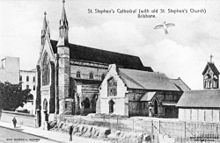 All Hallows' School 1861–1863 location within the building in the foreground of St Stephen's Cathedral, c. 1910
All Hallows' School 1861–1863 location within the building in the foreground of St Stephen's Cathedral, c. 1910
Contrary to the development of most schools, All Hallows' School, as the first Catholic secondary school in Queensland,[6] sought to serve those less fortunate in colonial society while operating under the same legislative framework as the more affluent grammar schools. Serving poorer, often Irish, Roman Catholic, immigrant women in the area of Fortitude Valley, the School did not raise the required subscription for government aid and, in a time of bitter sectarianism within Queensland, the school maintained fierce independence in curriculum from what was seen by many within the Catholic community as attempts by a hostile secular government at interference. A leading supporter of the Sisters of Mercy in this approach was Bishop James Quinn.
The early Mercy Sisters and their students at this time played a significant role in the development of women's rights within Queensland. The details of the origins of All Hallows' highlight the concerns of the Sisters of Mercy for the plight of the working poor in colonial Queensland. All Hallows' began in 1861 as a plea from a future student to Mother Vincent Whitty of the Sisters of Mercy to become a boarder in the cottages next to the convent on Charlotte Street, where the Sisters were residing. Mother Whitty's desire was to create a community united under the goal of promoting "Dieu et Devoir" – "God and Duty" in Queensland's young women. This student, along with 16 other boarders from various socio-economic backgrounds, had become the pioneers in a long tradition of the education of women within Brisbane.
In the World War II the schools Main building held the USA Army Core.
Relocation to Duncan's Hill
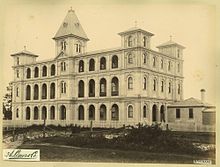 All Hallows' Main Building at Duncan Hill, c. 1889.
All Hallows' Main Building at Duncan Hill, c. 1889.
In 1863, with pupils and Sisters growing in numbers, it was soon realised that a suitable place for a convent must be found. It was envisaged that a small House of Mercy would be established on the site of what would become All Hallows' School. 1 November 1863 saw the transfer of the party from a small structure adjacent to what is now Saint Stephen's Cathedral to 'Adderton House' overlooking the Brisbane River from high upon Duncan's Hill.
"The Bishop has lately purchased the finest house and situation in Brisbane for a convent. The purchase money is 6,000 – where it is to come from I know not – but I trust God will send it. As soon as we get into it, we are to commence a House of Mercy ... The constant influx of Emigrants renders a House of Mercy desirable but it will not be a big one ..."[7]
Mother Vincent Whitty marvelled at the position of the new house in a way that many visitors to the school have done since 1863. Writing to Ireland with news of the move to Duncan's Hill she stated:
"I wish I could give you an idea of the beauty of the situation of this house. The view of the river from the Balcony is lovely and in the distance the thick bush, is here and there cleared away, with the town at one side of the River, it certainly is very beautiful."[8]
Adderton House
Adderton House was constructed in 1858 by John Petrie for Dr. George Fullerton (Mahoney, 1985 p. 6). The school was given the of All Hallows' by Mother Whitty who, while well acquainted with All Hallows College in Dublin, named the new Brisbane school after a seventh century church – All Hallows-by-the-Tower in London, England. All Hallows-by-the-Tower is the earliest parish church in London and Mother Vincent Whitty was aware that the Dublin College was named for the priory on which it was built, which in turn was named after this other famous London landmark.
Adderton House, is still present on the school grounds along with other heritage buildings such as McAuley Hall, Main Building (a prominent turreted structure) and St Ann's.
House system
All Hallows' has a mixed age house structure. Every student and staff member belongs to one of the eight houses which are named after people or places within the history of the school. Each house is given a color.
- Adderton – green, named after Adderton House building on the school grounds.
- Coolock – blue, named after the house in Ireland where Catherine McAuley lived.
- Gorry – gold, named after Queensland born Mercy Sister Jane Gorry.
- Loretto – pink, named after long serving school principal Sister M. Loretto Flynn. Principal: 1916, 1933–1959.
- McAuley – silver, named after the founder of the Mercy Sisters, Catherine McAuley.
- Mercedes – orange, pronounced /mɛərˈseɪdɛs/ mair-say-dess as per the Spanish word for 'Mercy'.
- Tighe – indigo, named after the first enrolled student at AHS, Annie Tighe.
- Whitty – red, named after the first principal of AHS, Mother Vincent Whitty.
Each house is divided into seven "home groups" led by teaching staff. These home groups meet each morning and for regularly timetabled extended periods. Each of the Houses is led by a House Co-Ordinator who, in turn, work closely with the Deputy Principal and other support staff.
Throughout the year, interhouse and intrahouse competitions are held. The most significant interhouse competitions include: swimming, cross country, debating, House choir and athletics. Each house holds its own range of intrahouse activities largely organised and led by students. These activities include: Girls' Nights In, social justice work, team building activities and initiative challenges. Student house leaders encourage home groups to compete for intrahouse trophies (such as the "McAuley Cup" and the "Gorry Grail").
Co-curriculum
Associations and competitions
All Hallows' is a member of sporting and other associations including:
- Brisbane School Girls' Sports Association
- Queensland Debating Union
- Queensland Netball
- Independent Schools' Soccer Association
- The Associated Schools' (Junior)
- Gateway District Sports Association
- Metropolitan East District Sports Association
The School takes part in competitions including the:
- Duhig Cup (swimming)
- Beirne Cup (athletics)
- Knowles Cup (tennis)
- Queensland Schoolgirls Water polo Championships
- Queensland Schools Futsal Championships
- Uhlsport Cup (football)
- Queensland Swimming Championships
- Catholic Tennis Championships
- Brisbane Schoolgirls Rowing Association rowing
- Queensland All Schools volleyball
- Queensland Catholic Schools Touch Championships
- Queensland Catholic Music Festival
- Queensland All Schools Touch Championships
- Queensland Individual Schools' Fencing Events (fencing)
- Brisbane Waterpolo (Waterpolo)
Clubs and societies
All Hallows' School supports the activities of parent support groups which act in a similar way to community groups or clubs within the AHS school community. These support groups encourage parental assistance in the running of school groups and fundraise for their clubs. Support groups act under the auspices of the Parents' and Friends' Association.
Parent Support Groups at All Hallows' include:
- AHS Water Polo
- All Hallows' Touch Football
- All Hallows' Netball
- All Hallows' Hockey
- All Hallows' Rowing
- All Hallows' Football and Futsal
Student based clubs and societies at All Hallows' include groups such as Amnesty International and the Mercy Action Group.
Traditions
Some traditional aspects of the school daily life include:
- Students celebrate each other's birthdays with gifts of a single flower (often a gerbera). The origins of this tradition are unclear but this tradition continues to this day. Gerbera flowers have grown on the school campus in a variety of areas around the convent for many years.
- The school Angelus bell rings to this day at midday. The bell is rung by year 10 students and is rung to a distinctive pattern. The bell (called "Charles Borromeo" in honour of the saint by the same name by boarders in the 1880s) was donated to the Sisters of Mercy by Dublin lawyer Charles Cavanagh and was hung in its current location in 1882.
- Senior Badge Swapping. On the final day of school for graduating seniors, a ritual of senior badge swapping takes place in which the outgoing Year 12 students "commission" their successors in the current Year 11 classes.
- Jumping Jive. The unofficial warcry of All Hallows', this chant is performed by students at, before or after significant school events. It is especially common as a "wishing" of good luck or congratulations. Jump'n'Jive is performed by groups of students with arms linked over each others shoulders to form a circle. As the chant is performed, students bounce to the rhythm of the words. Occasions when this warcry is performed include at swimming carnivals, after athletics and cross-country meets, prior to rowing regattas, on the final day of graduating students, after significant group victories or individual achievements, after most victorious sporting events, and following the Senior Graduation Mass.
- Inaugural Mass and Commissioning of School Leaders. Originally held in St Stephen's Cathedral, the Inaugural Mass is now annually held during February at the Brisbane City Hall. This is a formal Eucharistic celebration incorporating commissioning of staff, parents and students into their roles. This event marks the formal commencement of period of office for school captains and house captains as they receive their badges from the Head of the Queensland Congregation of the Sisters of Mercy.
- All Hallows' Day Mass and Picnic Day. Since 1861, All Hallows' Day (All Saints Day) has been observed with a formal school Eucharistic celebration (now held in Brisbane City Hall) and with the informal student-based picnic day. The picnic day has on occasion been held at locations such as Caloundra and Mt Cootha National Park. In recent years, the entire school has celebrated its foundation with an excursion to Amazons and more recently at the Wet'n'Wild Water World aquatic theme park on the Gold Coast, Queensland.
- Singing the Angeli. The school song (La Toussaint) is sung in Latin at the commencement of school assemblies and significant events. Senior students graduating at the close of their final school year are farewelled from the school with a mass singing of this song.
- The Mother's Day May Morning Tea. Every year the All Hallows' Ladies committee hold a morning tea in May to celebrate Mother's Day. Many old girls attend, and the event has become so popular that in 2008 it was moved from the school grounds to the Brisbane city hall to accommodate the amount of people wanting to attend. In 2008 the guest speaker was Maxine McKew.
School uniform
The school uniform, designed by a committee of parents, students, past-students and staff in mid 1990s, incorporates the white, sky blue and rust colours associated with AHS' history.
The All Hallows' formal school uniform consists of a blouse and skirt (coulottes for the All Hallows' Middle School) predominantly sky blue in colour with fine white pin-striping. Piping on the collar of the blouse is in the traditional rust brown. This uniform is worn with a white straw hat with sky, white and rust band which incorporates the school crest and motto. This uniform is worn with brown leather shoes and white socks for the secondary school and blue socks for the middle school.
The All Hallows' School sports uniform consists of a white polo-style shirt with sky blue collar and either a sky blue netball skirt or shorts.
Notable alumnae
Former students of All Hallows' are known as "Old Girls"; they may elect to join the 'Past Pupils' Association'.[9]
- Elizabeth Alexander, actress and dramatist
- Thea Astley, author and novelist
- Fran Bailey, member of the House of Representatives, Parliament of Australia
- Nina Clarke, Camp Orange contestant 2007
- Sarah Crane, opera singer
- Ellen Fanning, journalist
- Diane Fingleton, first female Chief Magistrate of Queensland
- Teresa Gambaro, member of House of Representatives, Parliament of Australia
- Miranda Kerr, model
- Mary Emelia Mayne (1858–1940), philanthropist[10]
- Maxine McKew, ALP member of the House of Representatives seat of Bennelong
- Tracey Wickham, Australian swimmer (Olympics and Commonwealth Games)
Gallery
Historic images of All Hallows' 1860–1942
-
All Hallows' School (Main Building) dominated the Brisbane skyline during the 1893 Brisbane floods. This view shows the flood waters at Kangaroo Point in the foreground.
-
During World War 2, Brisbane was the headquarters of the Supreme Commander Allied Powers (Pacific), US General Douglas MacArthur and as such a major military staging point. In this image, Australian troops take part in a parade along Ann Street during 1942. Note the All Hallows' gates in the background.
Modern images of All Hallows'
-
The Consilo Aquatic Centre (part of the 2006–7 Dodge Lane Project) incorporated an Olympic standard water polo pool (2 side by side courts), a gymnasium, 300 seat auditorium (the Claver Theatre), and Piazza as well as seating, performance and parking areas. Visible in the background of this image are the Loretto and Mercy Hall indoor courts and assembly complexes (curved roof structure) and Aquinas classroom block.
Other
See also
References
- ^ a b c "School Reporting Requirements – 2007: Data from the 2006 school year". All Hallows' School. 2007. Archived from the original on 29 August 2007. http://web.archive.org/web/20070829232145/http://allhallows.qld.edu.au/govreports/schreport.asp. Retrieved 8 September 2007.
- ^ "All Hallows Convent and School". Queensland Government: Cultural heritage. Archived from the original on 24 August 2007. http://web.archive.org/web/20070824042741/http://www.epa.qld.gov.au/projects/heritage/index.cgi?place=600200&back=1. Retrieved 8 September 2007.
- ^ "AHISA Schools: Queensland". Association of Heads of Independent Schools of Australia. April 2007. Archived from the original on 29 August 2007. http://web.archive.org/web/20070829153048/http://www.ahisa.com.au/Display.aspx?tabid=2232. Retrieved 8 September 2007.
- ^ "Member Schools". Alliance of Girls' Schools Australia. http://www.agsa.org.au/members.php?PageID=11&Alpha=A. Retrieved 8 September 2007.
- ^ "All Hallows' School, Brisbane". Australasian Mercy Secondary Schools Association. http://msea.mercy.org.au/resources/mercy/all_hallows_school.html. Retrieved 8 September 2007.
- ^ The All Hallows' Story
- ^ M. Vincent Whitty on 18 August 1863 in Mercy Women Making History, 2001, pp. 61–62
- ^ M. Vincent Whitty on 19 October 1863 in Mercy Women Making History, 2001, pp. 71–72
- ^ "Past Pupil's Association". All Hallows' School. Archived from the original on 29 August 2007. http://web.archive.org/web/20070829233545/http://allhallows.qld.edu.au/past_pupils/contact.asp. Retrieved 8 September 2007.
- ^ Crouchley, Betty (1986). "Mayne, Mary Emelia (1858–1940)". Australian Dictionary of Biography. Canberra: Australian National University. http://adb.anu.edu.au/biography/mayne-mary-emelia-7781. Retrieved 30 August 2011.
Sources
- Fitzgerald, R. (1984) A History of Queensland: 1915 to the Early 1980s, Brisbane: UQP.
- Johnston, W. Ross (1982) The Call of the Land: A History of Queensland to the Present Day, Brisbane: Jacaranda.
- Mahoney, J-M (1985) Dieu et Devoir: The Story of All Hallows' School Brisbane, 1861–1981. Brisbane: Boolarong Publications
- Mercy Women Making History: From the Pen of Mother Vincent Whitty (2001) Brisbane: Corporation of the Trustees of the Order of the Sisters of Mercy in Queensland.
- State Library of Queensland, Picture Queensland: All Hallows' School
- Women Making History: A Heritage Exhibition Celebrating the First 40 Years of the Sisters of Mercy in Queensland 1861–1901 (2000), Brisbane: Sisters of Mercy – Brisbane Congregation.
External links
Categories:- Girls' schools in Australia
- Roman Catholic schools in Australia
- Private schools in Queensland
- High schools in Queensland
- Educational institutions established in 1861
- Sisters of Mercy
- Schools in Brisbane
Wikimedia Foundation. 2010.













